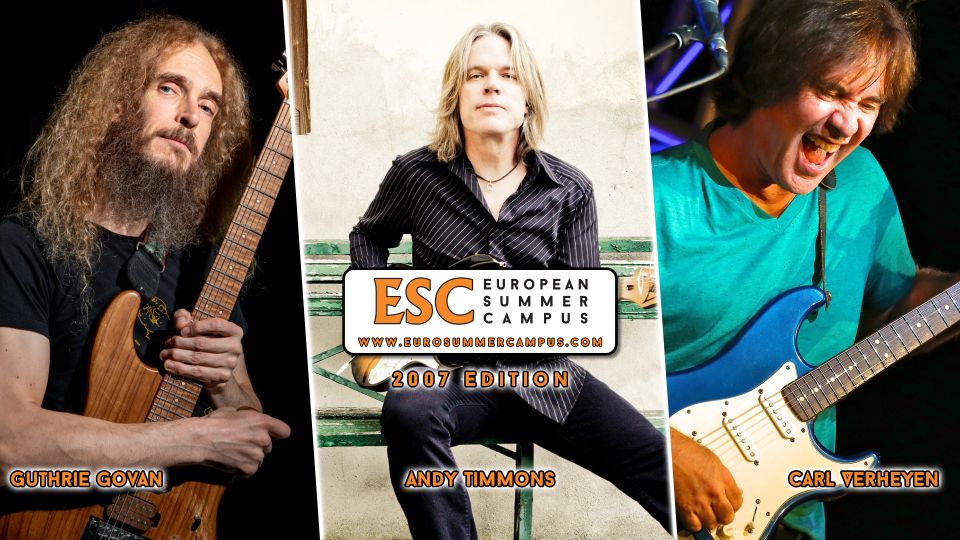The 2007 edition saw a series of important innovations for the ESC (European Summer Campus), such as the change of the location which moved to the precious Palazzo Impellizzeri, located in Via Maestranza in Syracuse, always located in the heart of the Ortigia island.
This new structure was arranged by a large hall, where the lessons of the Campus took place, but also a large initial atrium where each student could safely stop before or during the lessons. This larger structure has allowed the presence of many more students from various parts of the world, which confirm how well this educational event is known outside the Italian borders.
The artists invited for the 2007 edition were Guthrie Govan, Andy Timmons and Carl Verheyen, who had already participated in the previous 2006 edition and that the organization decided to invite again due to the importance of its didactic contents, which aroused interest from the participants already in the first edition. The great double bass player Andrea Avena has been recalled as a theoretical teacher.
Birdland Bookstore held a section dedicated to various media was made available, including educational books and DVDs, including the autographed discography of the artists present.
Initially, Scott Henderson was invited who later, due to a family problem, was unable to participate and was replaced, a month before the event, by Andy Timmons on tour in Europe during the days of the ESC.
To reiterate the importance of Ear Training, we find Andrea Avena again, who had also started the lessons the previous year. The focus on the ear is very important for the double bass player, who also gave a lesson on the triads of a II V I minor, highlighting the dissonant notes to never use and those consonants that are interesting and pleasant.
Carl Verheyen, with the same Strat Daphne Blue from the previous year, leaves everyone speechless with a first jazz-blues improvisation to begin with. He tells his experience and the influences of various genres, from The Beatles to Jimi Hendrix, from pop rock to jazz, with an in-depth study of the modes. His motto is “if you like it, you have to learn it”. In fact, a fundamental skill is the reading, very important for a session player, and also the accompaniment, which he divides into three types: “cowboy” chords, fingerpicking chords and jazz chords. He shows examples of voicing chords that use open strings to be very musical and expressive, but without clashing with other instruments (very particular the “two note” chord of G7 in which he plays only 3rd and 7th).
These are the results of a study based on repeated listening to records to bring out teaching, something that, with the Internet, is now outdated but not forgotten.
His advice on improvisation is to play pentatonic and major scales on the whole neck following the circle of fifths, or to identify a note and its octaves on the fretboard… with your eyes closed! The scale should be used in a melodic and non-trivial and mechanical way. His style is very focused on wide intervals that he reaches with representative slides.
He recommends training your fingers so that all four sustain the same vibrato, but he does not mean that you have to always use the same type of vibrato.
Guthrie Govan, English session man and columnist of “Guitarist” magazine, is a gem for this year’s technique lessons. Although his guitar was lost at the airport, he has not lost the good humour or virtuosity that characterise this flawless musician.
He shows a legato over pentatonic pattern and an amazing and fast “Friedmanian” sweep picking, followed by a Satriani-style arpeggio made only of hammer-ons (precision is a must). We also add eight-finger tapping (like making thumbs feel excluded) to enhance his prowess.
He advises to play with little pressure on the left hand to avoid hearing the sound of the fret and the right leans lightly on the strings to reset the resonances (for this he does not use the pick).
Andy Timmons gives a lot of importance to “mechanical” warm-up (unlike Verheyen, who sees it as a mere exercise), starting slowly and continuing at high tempo.
Everyone has their limits, in fact he admits that he is not very good at sweeping and makes up for it with alternate picking, slides and pull-offs to emulate the Malmsteen style.
What remained in everyone’s ears is the powerful distortion of a Mesa Boogie coupled to his Ibanez, on which he decides to do a compositional experiment: everyone writes a simple chord on a piece of paper, you see them in progression and he plays a melody – this too remained in everyone’s ears.
He recommends practicing the dynamics, with the help of playing with the amplifier turned off, and suggests using strings with great thickness and high action to make a more full-bodied sound.
Many students had the opportunity to play together with great guitarists, providing them with unique experiences that are difficult to replicate, given the simultaneous presence of the artists present.
Each participant was given the end of Campus certificate according to the “ritual method” which was then repeated every year: all the artists sitting on the stage together with the ESC President, Andrea Quartarone, called each student who received the own attested directly by the artists.
Also for this year the IGJ (International Guitar Jam) took place in the fantastic open air theatre of Marina di Modica (RG) which gathered hundreds of users and which saw the three artists playing together with the Andrea Quartarone concert opening. ELEKTRIO.
ARTISTS

